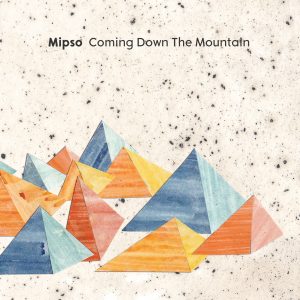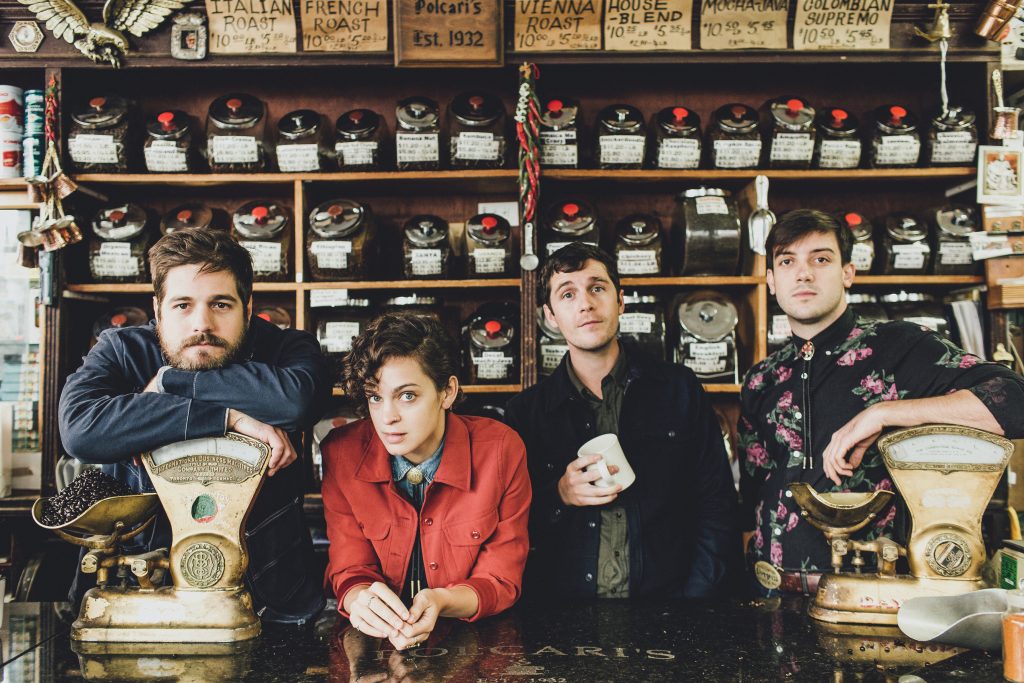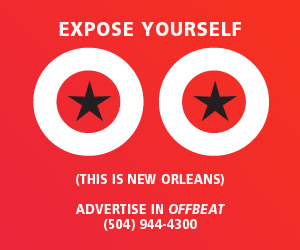After an unexpected eight years together, Mipso has plenty of success to celebrate. This spring they released their third full album Coming Down the Mountain, a packed summer tour is on the horizon. From beginnings that were as humble as their music, the band has grown with each new recording and matured with time out on the road.
 Mipso is a bluegrass string quartet comprised of Joseph Terrell (guitar), Jacob Sharp (mandolin), Wood Robinson (bass) and Libby Rodenbough (fiddle). All four members of the group contribute to the vocal harmonies that accompany the folk/americana-style of their tunes. Mipso’s sound was undoubtedly born out of Appalachian traditions, with their folk and bluegrass roots, but a more contemporary style has come to fruition with their newest album, an effort that features additional instruments like the drums and electric guitar.
Mipso is a bluegrass string quartet comprised of Joseph Terrell (guitar), Jacob Sharp (mandolin), Wood Robinson (bass) and Libby Rodenbough (fiddle). All four members of the group contribute to the vocal harmonies that accompany the folk/americana-style of their tunes. Mipso’s sound was undoubtedly born out of Appalachian traditions, with their folk and bluegrass roots, but a more contemporary style has come to fruition with their newest album, an effort that features additional instruments like the drums and electric guitar.
The band’s previous album, Old Time Reverie, debuted at #1 on the Billboard Bluegrass in October 2015, and their snowballing popularity is evident in the extensive touring schedule ahead of them. Mipso’s success may have been unexpected, but it is certainly not slowing anytime soon. Coming Down the Mountain was released April 7, and was extremely well received by loyal North Carolina fans and listeners around the country alike, spending five weeks on the Billboard Bluegrass Album Charts.
Mipso has been touring in support of the new album, and will be making a stop at Gasa Gasa in New Orleans on Saturday, June 24. Mandolinist Jacob Sharp took the time to talk with us about the upcoming show, what it’s like being on the road, the new album and more.
Can you tell me a little bit about how the band came together?
We met about eight or nine years ago, we were all students at The University of North Carolina, Chapel Hill. We started playing just for fun and had been asked to play a few shows, then formed a band after that started.
Our first tour was actually in Japan and China right after we graduated. We came back and put out our first album and it debuted on the Billboard Bluegrass Charts. So all of a sudden we were a real band and started touring all over the country. We’ve had another two albums since then and we’ve played, on average, about 160 shows a year. So it kind of transitioned from this fun, joyous, friends-making-music-together to what feels like a pretty serious part of our life now.
What has the support been like from back home in North Carolina after this album? What’s the feeling back where this all started?
It’s been great. This one was interesting. We actually recorded this album in Durham and Chapel Hill at two different studios. The producer, Brad Cook, is a Durham guy and all the guest musicians were also from that music scene. Last summer, when we recorded it, we recognized that this is a celebration of this community that has fostered us so much. But you record the album and it kind of just sits in nowhere land for a few months before it comes out. This one actually came out ahead of its release, and we were on the road for two months elsewhere in the country. About three weeks after the release date we came home and played what was our biggest show ever at the North Carolina Museum of Art amphitheater in Raleigh. It was really cool to have seen the response across the country, and to be hearing that, in the radio and press stuff back home, it was well received. To come back a couple weeks after and have our hometown crowd grow so large—and singing along to all of the songs—was a special celebration of what we think is one of the cooler music communities in the country.
You mentioned that you guys have added some additional instruments to this album. Are these musicians going to be coming with you on tour?
We didn’t go into the album thinking, necessarily, that we were going to expand the sound as much as we did. We definitely weren’t thinking we were going to add touring members for sure. We are a band that loves songs. We treat the song, and each batch of tunes, how they’re best served to get that emotional content across. When we got into the studio, we added the drums on a couple of tracks and we were like ‘this really works’. Before we knew it, it was on most of the album.
Who were the other musicians that were featured on the album?
There’s the drummer Yan Westerlund, Phil Cook who played all sorts of keys, Eric Heywood on pedal steel, Andrew Marlin (from Mandolin Orange) on clawhammer banjo and Josh Oliver (also from Mandolin Orange) on electric guitar. They weren’t all there at the same time during the recording process. Somebody would stop by everyday and add these—we see them as textures—to what the core of the song is. It was a really rewarding process to allow everybody we really respect and love to have their own little influence as well.
The album debuted on the Billboard Bluegrass Chart. Do you think that genre is a good definition of what your sound is?
I think the terms and categories we place music under now are more useful to the people who listen or talk about the music, probably and less-so to us. We’ve never been too concerned with a specific genre label. We all love bluegrass and traditional bluegrass, and even in our early stuff we didn’t actually think that we fit into that. Certainly, as a genre goes, it’s a big one that we’ve taken influence from. But I think we find ourselves to be more a part of the greater Americana/folk scene than bluegrass specifically.
Did you guys have any specific inspiration for this album?
This album was the first time we had a big run up period ahead of it. We started bringing these tunes together in March of last year. Between March and June, we took a week off of the road and settled into different cabins: one in Wisconsin and one in North Carolina. We shared music that we were being inspired by in that moment and some of the early ideas of the songs. One of the common touchstones for the album was thinking about the sounds of the 1970s, in Laurel Canyon in Los Angeles. We were thinking about how some of those roots rock bands were able to stay true to—or honor—traditions, but still have a pretty wide scope.
Does one of you primarily write the music? Or is it a pretty even collaboration from the four of you?
It’s a joint effort. I would say that, by the time the song is on the album, it certainly is a product of all of us. All of us write. Libby and Joseph did the majority of the songs on this album, and there’s some collaborations on there as well. Generally, somebody comes with the initial impetus or idea for a song. Sometimes that’s all of the lyrics, maybe not a coherent structure. Sometimes it’s just a chorus or a hook line, then we kind of collectively arrange it.
How much of Coming Down the Mountain can we expect to hear played at Gasa Gasa?
You’ll hear the whole thing. We’ve been flushing the set out, and have been playing a longer set these days. We’re generally doing the whole album and then kind of doing the ‘best of’ from the past albums, and also a couple of fun covers as well.
Have you guys played in New Orleans before?
Yea, its one of our collective favorite towns. I remember the first time we played in New Orleans, we played a house concert in the Garden District. We were coming off of a month and a half in the Northeast in the wintertime ,and we drove basically overnight to get to New Orleans. We felt like we had arrived in the Garden of Eden. It is the most beautiful, culinary, cultural paradise. I think this will be our fourth show in New Orleans, and ever since then we’ve had a mandate with our booking agent that we have to have either the night before or after a New Orleans show off so we can explore our favorite bars and restaurants. This’ll be our second time at Gasa Gasa. We love it. It’s such a cool little example of the quirkiness of New Orleans that we all love.
How would you say this tour is different compared to your previous ones? Other than the fact that you guys toured in Japan.
Well, at this point, playing as many shows as we do across the country, there’s a familiar circuit of stopping in most of these towns at least once a year. Some of them twice. We’ve already played 85 shows this year, but we are about to announce a 50-date fall tour across the whole country. We’ve got a couple more festivals this summer too that we are really excited about. It feels like stage two of bringing these new tunes across the country, and it’s fun now that the album has been out for over 2 months. It feels like the songs have kind of marinated in better ways and we are presenting a pretty mature version of them. So we’re just excited to keep on sharing it.
Do you feel any different being on the road for that long? How’s it been traveling?
It’s fun. One of the things I love most about being a touring musician is that you get to learn about, and connect with, all these different communities across the country. I think otherwise you’d struggle to have such a wide open door and warm greeting into many of them. But you have this really limited time while you’re there to take advantage of it and to be apart of the community, to feel its individual notes and the things that really make it special. It’s something we love to do. And New Orleans is one of those places where we inevitably try and rise to the energy of those crowds and the city.
We definitely don’t take it for granted. Its one of those things where, when you’re in the rhythm of it, it feels like it’s growing in concentric circles. But then you look back and you notice there’s this stronghold spread out. Touring is like connecting the dots between those places.
You guys have a playlist on Spotify called “Mipso Loves and Influences.” Could you talk about some of the love and influences for you guys as a whole?
That playlist actually is a good example of where we’re similar and different. Each of us contributed about a quarter of those songs. We have pretty different tastes. If there was a Mipso Venn Diagram, there would be some stuff in the center we all agree on. But I think our outer reaches of our favorite music, neither of the other band members enjoys. It’s a crazy time to be a musician because you’re exposed to so much all the time. There’s amazing music being made at what seems like a much more frequent rate than in the past. We’re lucky that so many of those people are now our friends, and that we get to collaborate with people that we see a few times a year at different festivals and concerts. We are always paying attention to our peer bands and our favorite bands who are putting out new stuff, but we also keep it well balanced with our favorite classics.
Is there anyone you’d like to acknowledge for supporting your endeavors, especially with this new album release?
Brad Cook, the producer of this album. He was such a great coach and encourager during the when these tunes came out, and for us as a band. Being in a band, especially now as much as we travel, is a balancing act of being inspired by one another and also offering space because you need it. He was the perfect coach through that experience. He really helped us out on the musical front, pulling at some ideas that were incoherent in our heads but hadn’t fully executed before. He assembled quite the team around it.





